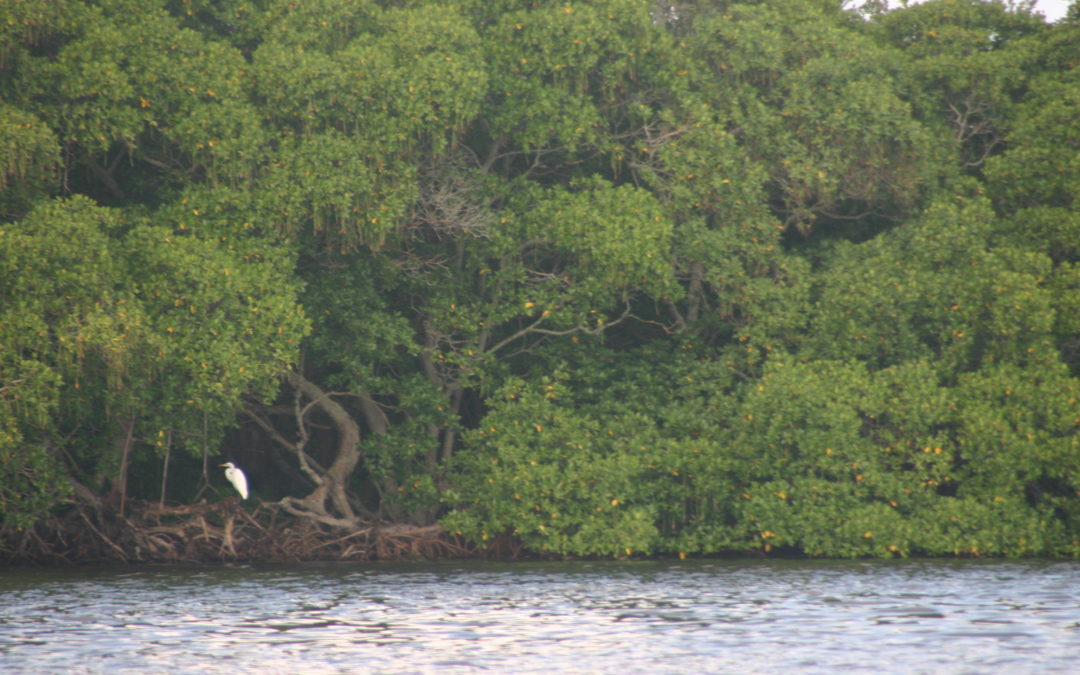A week or so ago at our annual club casting clinic, I believe it was Rod who brought up the point that when fishing mangrove shorelines he liked to always throw flies that were tied with weed guards. The club is the Charlotte Harbor Fly Fishers. A casual group of good people that just hang out once in a while and talk fly-fishing, tie flies, or work on casting skills. No rules; just fun. Anyway, Rod brought up that if you’re going to get your fly back in the bushes close to where game fish hang out, you’re going to eventually get hung up in the trees. And, if you’ve ever worked a mangrove shoreline, no matter how accurate of a caster you are, you know the feeling. His point was, that in many cases, the weed guard often helps put our presentation in the strike zone as the fly will just sort of drop out of the tree edges with a little finesse from the angler.
This got me to thinking of all the times the exact same scenario happened to me while throwing a soft plastic shrimp or jerk bait with conventional spinning gear. First off, let me preface this whole idea by the fact that on every single cast I am aiming for a spot up under or just on the edge of the overhanging mangroves. Unfortunately, I am not accurate enough to hit my mark each time over the course of hundreds of daily casts and quite a few eventually sail into the bushes. However, because of the way we rig our baits, just about all of these can be gently pulled away from the bushes and dropped right at the edge of the cover. Being as these casts were not placed exactly where I had in mind, but still salvageable, I would joke around and refer to them as one of my tree shots. And when you think about it, in the natural world, there just isn’t much better of a presentation than some kind of easy meal like maybe a small crab falling from a prop root. Believe me, when a small artificial bait drops from a branch just above the waters surface, it is generally a much softer drop than that from a long cast.
My point is that keeping this in mind should help benefit anyone that is a bit hesitant about taking the shot. You may have heard the saying “if you’re not in the bushes once in a while; then you’re not putting your bait in the strike zone.” Now, I’m definitely not an advocate of leaving fishing line hanging in the bushes after having to break off line from a snag. I do see line hanging from branches quite often and do my best to pull them free. And actually, the abandoned lines I do find are typically single J hooks or baits rigged with exposed hooks. I find very few with a bait that has been rigged weedless. Most importantly, I know there are anglers out there that are intimidated by the bushes. In fact, I know quite a few good anglers from different regions of Florida where this type of technical casting isn’t necessary because there are no mangroves and it even took them some time to get comfortable throwing into the heavy cover. No doubt, rigging their baits weedless helped make the transition easier. Just as they did, if we take the time to rig appropriately we will in turn both gain more confidence and catch more fish.
When it comes to setting up the shot, with enough practice you can actually skip the bait up under the bushes, however, at first it is a bit easier to just aim at the bottom edge of the bushes. What generally happens is that some casts will stray a bit high and end up on the edge of one of the limbs. This is where you can softly tug the bait so it falls just along the edge.
All in all, you’re not really aiming at the bushes. It is just that knowing if you do end up there, all is not lost. Hopefully, this will provide the confidence needed to keep working on it until we become more proficient casters. I have seen with my own eyes how effective it can be to get a bait way up under the bushes. This can be a tough cast to make and takes a lot of confidence. On the other hand, I have also seen lots of fish pulled from mangrove edges and this is a much easier cast to make, especially if you can bounce a few off the trees. Besides, if you keep working the edges, it’s only a matter of time before you’ll be further back.


Recent Comments